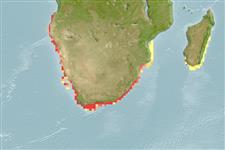>
Eupercaria/misc (Various families in series Eupercaria) >
Sparidae (Porgies)
Etymology: Rhabdosargus: Greek, rhabdos = stick + Latin, sargus = sargus (1591) (Ref. 45335).
More on author: Valenciennes.
Environment: milieu / climate zone / intervalo de profundidade / distribution range
Ecologia
marinhas; estuarina bentopelágico; oceanódromo (Ref. 51243); intervalo de profundidade ? - 100 m (Ref. 3198). Tropical; 13°S - 36°S
Southeast Atlantic: Angola southward around coast of South Africa to Natal. Reported from Mozambique (Ref. 5213).
Length at first maturity / Tamanho / Peso / Idade
Maturidade: Lm 23.0, range 22 - 24 cm
Max length : 65.0 cm TL macho/indeterminado; (Ref. 3688); common length : 40.0 cm TL macho/indeterminado; (Ref. 3688)
Descrição breve
Chaves de identificação | Morfologia | Morfometria
Espinhos dorsais (total) : 11; Raios dorsais moles (total) : 11 - 13; Espinhos anais: 3; Raios anais moles: 10 - 11. Silvery with distinct crossbars (Ref. 3198).
Body shape (shape guide): fusiform / normal.
Found over sandy substrate. Juveniles use estuaries as nurseries (Ref. 27121). Feeds on worms, crustaceans, and mollusks especially mussels (Ref. 5213). Spawns during spring and summer close inshore (Ref. 36731).
Life cycle and mating behavior
Maturidade | Reprodução | Desova | Ovos | Fecundidade | Larvas
Conflicting descriptions of the reproductive style of this species have been reported, e.g., Ref. 4359 describe this species as being a gonochorist (Ref. 28504). Also Ref. 103751.
Bauchot, M.-L. and J.-C. Hureau, 1990. Sparidae. p. 790-812. In J.C. Quero, J.C. Hureau, C. Karrer, A. Post and L. Saldanha (eds.) Check-list of the fishes of the eastern tropical Atlantic (CLOFETA). JNICT, Lisbon; SEI, Paris; and UNESCO, Paris. Vol. 2. (Ref. 3688)
Categoria na Lista Vermelha da IUCN (Ref. 130435: Version 2025-1)
Ameaça para o homem
Harmless
Utilização humana
Pescarias: pouco comercial; peixe desportivo: sim
Ferramentas
Relatórios especiais
Descarregue XML
Fontes da internet
Estimates based on models
Preferred temperature (Ref.
123201): 14.5 - 26.4, mean 23.8 °C (based on 102 cells).
Phylogenetic diversity index (Ref.
82804): PD
50 = 0.5156 [Uniqueness, from 0.5 = low to 2.0 = high].
Bayesian length-weight: a=0.01259 (0.00609 - 0.02604), b=3.03 (2.86 - 3.20), in cm total length, based on LWR estimates for this (Sub)family-body shape (Ref.
93245).
Nível Trófico (Ref.
69278): 3.0 ±0.2 se; based on diet studies.
Generation time: 6.9 ( na - na) years. Estimated as median ln(3)/K based on 1
growth studies.
Resiliência (Ref.
120179): Médio, tempo mínimo de duplicação da população 1,4 - 4,4 anos (K=0.16).
Fishing Vulnerability (Ref.
59153): Moderate to high vulnerability (54 of 100).
🛈
Climate Vulnerability (Ref.
125649): Moderate to high vulnerability (48 of 100).
🛈
Nutrients (Ref.
124155): Calcium = 72.5 [39.7, 137.6] mg/100g; Iron = 0.8 [0.4, 1.5] mg/100g; Protein = 18.4 [17.3, 19.5] %; Omega3 = 0.232 [0.139, 0.391] g/100g; Selenium = 65.5 [32.2, 121.5] μg/100g; VitaminA = 22.4 [7.0, 57.1] μg/100g; Zinc = 1.46 [1.01, 2.07] mg/100g (wet weight);
